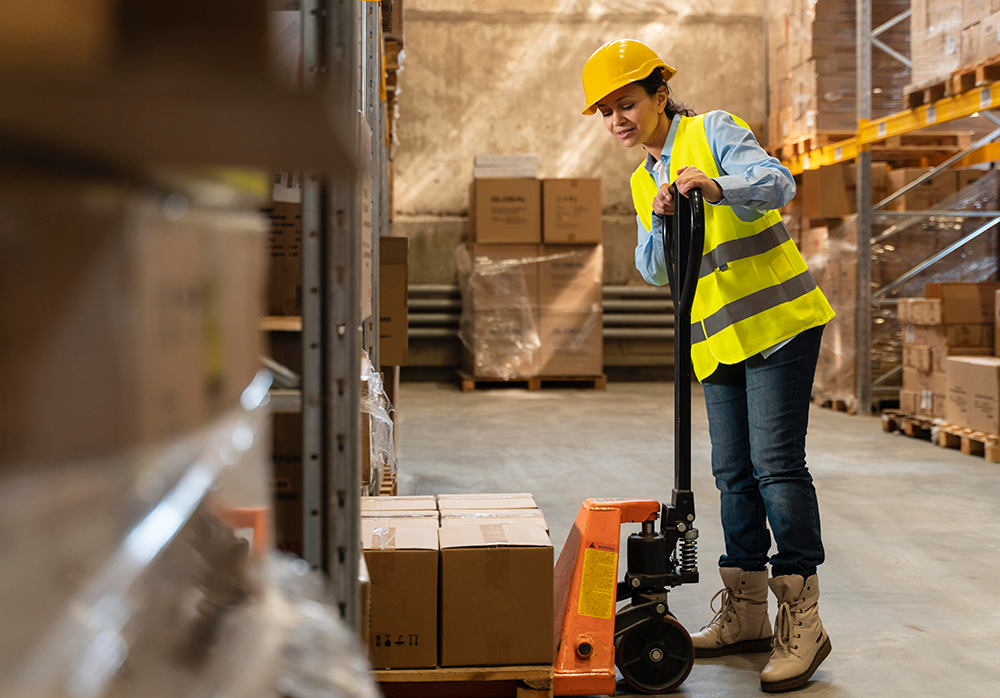Navigating the Maze: Attracting Young Talent and Embracing Tech Solutions in the Warehouse Labor Shortage
The global supply chain—the intricate network that delivers goods to our doorsteps—faces a critical challenge: a labor shortage in warehouses and distribution centers. How bad is it? A study released by Descartes Systems Group in January 2024 revealed that:
- 76% of the supply chain and logistics leaders surveyed are experiencing notable workforce shortages in their operations.
- 37% of respondents would characterize the resource shortage they face as high to extreme.
- 58% specify that workforce shortages have negatively impacted service levels.
- Areas suffering the most from resource shortages are transportation operations (61%) and warehouse operations (56%).
This isn’t simply a temporary inconvenience; it’s a persistent strain on efficiency, impacting everything from product availability to delivery times.
While competitive wages and benefits are crucial, attracting and retaining a younger workforce requires a more strategic approach. According to Descartes, “Supply chain and logistics and, ultimately, business performance is driven by the quantity and quality of the workforce. Supply chain and logistics leaders need to rethink their strategies for hiring and retaining workers and how technology mitigates the workforce challenges they face today and in the future.”
We’re going to delve into the need to bridge the gap between warehouses and younger generations, exploring how technology and online training can be the key to unlocking a more skilled and engaged workforce.
Why Warehouses Struggle to Attract Young Talent
A Berkshire Grey report from 2022 found that 64% of chief supply chain officers noticed “generational differences in employment preferences that will have a long-term impact on labor availability. Along with many warehouse laborers permanently leaving the field due to a multitude of factors including re-skilling, pandemic-related illness and an aging workforce, the industry is also being hit with a combination of population forces: the lowest birth rate in U.S. history paired with Baby Boomers retiring out of the workforce, as well as a generational shift in what employees are looking for in their careers and workplaces.”
The traditional image of warehouse work—physically demanding, repetitive tasks in a potentially dull environment—doesn’t resonate with many young job seekers. They often prioritize work-life balance, career growth opportunities, and a sense of purpose in their jobs. Let’s look at how Generation Z views this important part of the labor force.
The Myth of the Manual Laborer
Warehouses are rapidly evolving from static storage spaces into dynamic hubs powered by automation and robotics. While physical activity remains a part of many roles, opportunities exist for problem-solving, analytical thinking, and even data analysis.
Career Trajectory Disconnect
Career guidance programs often paint a bleak picture of warehouse jobs as dead ends with limited room for advancement. The reality is quite different. Warehouses offer a variety of career paths, from logistics management to supply chain coordination, with opportunities for specialization and skill development. Additionally, the logistics industry feeds into a vast network of transportation and distribution companies, offering ample avenues for growth within the broader sector.
The Allure of the “Cool” Factor
Let’s face it, warehouses haven’t exactly cultivated an image of being trendy or cutting-edge. Young people are drawn to industries that seem innovative and dynamic. Warehouses need to do a better job of showcasing the cool factor hidden in plain sight—the constant innovation in automation, the fast-paced environment that demands agility and critical thinking, and the vital role warehouses play in keeping the world’s goods moving.
Beyond Perception: Addressing Real Concerns
While the perception of warehouse work is a hurdle, it’s crucial to address the genuine concerns young workers might have.
Work-Life Balance
Younger generations of workers prioritize a healthy work-life balance. Warehouses can address this in numerous ways.
- Offering flexible scheduling
Implementing options like split shifts, compressed workweeks, or job-sharing opportunities can cater to various needs. - Predictable schedules
Providing schedules with ample notice allows workers to plan their personal lives and reduces stress. - Remote work possibilities
While not all warehouse roles are suitable, exploring remote options for administrative tasks or data analysis positions can attract talent seeking flexibility.
Compensation and Benefits
Competitive pay and benefits are essential for attracting and retaining young talent. Consider:
- Competitive wages
Research industry standards and offer wages that are attractive compared to other sectors. - Benefit packages
Provide comprehensive health insurance, paid time off (PTO), and retirement plans. Consider student loan repayment assistance programs as a unique perk. - Performance-based incentives
Offer bonuses, profit-sharing, or commission structures for exceeding targets to motivate employees.
Lack of Training and Development
Young workers are eager to learn and grow. Warehouses can demonstrate commitment to their future by:
- Investing in training programs
Develop comprehensive training programs that cover not only job-specific skills but also broader areas like soft skills development and leadership training. - Mentorship programs
Pair experienced employees with young workers to provide guidance and support throughout the learning process. - Tuition reimbursement programs
Offer financial assistance for job-relevant courses or certifications, demonstrating a commitment to employee development.
Building a Positive Work Culture
Beyond addressing specific concerns, fostering a positive work culture is crucial for attracting and retaining young talent. This includes:
- Recognition and appreciation
Recognize employee achievements and contributions regularly. This can be through public praise, rewards programs, or simply acknowledging a job well done. - Open communication
Encourage open communication channels between management and employees. This allows for addressing concerns quickly and fostering a sense of trust. - Safety and well-being
Prioritize employee safety with robust safety protocols and a focus on ergonomic practices to prevent injuries. Promote a healthy work environment that fosters well-being.
By addressing these concerns and building a positive work culture, warehouses can transform themselves into attractive destinations for young talent. This investment in their future workforce will not only help alleviate the labor shortage but also create a more engaged, skilled, and future-proof workforce for the ever-evolving world of warehousing and logistics.
The Allure of Technology and Online Training
Technology isn’t just transforming warehouse operations; it’s also becoming the key to attracting and training young talent. Here is why younger workers are more receptive to tech-powered training.
Digital Natives
The way younger generations learn has fundamentally shifted. Members of Generation Z are digital natives, having grown up surrounded by technology. This translates into a unique set of preferences when it comes to training and development.
Tech-Savvy and Comfortable with Exploration
Unlike some older generations who might see technology as a barrier, young workers embrace it. They’re comfortable navigating digital interfaces, exploring online resources, and readily accept technology as a learning tool.
Active Engagement Through Interactive Learning
Passive learning methods like traditional lectures often fall flat for digital natives. They crave active engagement, and warehouses can meet this need through:
- Interactive simulations
Imagine learning picking procedures in a safe, virtual environment that mirrors the actual warehouse layout. Virtual Reality (VR) and Augmented Reality (AR) create immersive simulations that make learning engaging and knowledge retention higher. - Gamified training modules
Introduce game mechanics like points, leaderboards, and challenges into training programs. This injects a sense of fun and healthy competition, motivating trainees to learn and excel. - Microlearning modules
Break down complex topics into bite-sized, easily digestible modules. This allows for focused learning on specific skills and reduces information overload, a common pitfall of traditional training methods.
Learning on Demand: Flexibility is Key
Young workers juggle various commitments. Traditional, rigid training schedules with limited accessibility can be a major turnoff. Online training platforms address this by offering:
- On-demand learning
The ability to access training materials anytime, anywhere allows young workers to learn at their own pace and around their schedules. - Mobile-friendly learning
By making training modules accessible through smartphones or tablets, warehouses empower workers to learn during commutes or breaks, maximizing flexibility. - Personalized learning paths
Online platforms can tailor training content based on individual learning styles and skill gaps, ensuring a more personalized and effective learning experience.
These tech-powered approaches not only cater to the digital-native preferences of young workers but also demonstrably improve learning outcomes. Studies have shown that interactive training methods lead to:
- Increased knowledge retention
Engaging learning experiences solidify knowledge more effectively than passive methods. - Improved skill development
Hands-on simulations and practical exercises allow for immediate application of learned skills. - Enhanced motivation and engagement
Gamified elements and interactive learning keep trainees motivated and actively engaged in the learning process.
By embracing technology and online training, warehouses can not only attract young talent but also equip them with the skills they need to succeed in the modern workplace. This shift towards a tech-driven training environment is a win-win for both warehouses and the future generation of logistics professionals.
Accessibility and Flexibility
The traditional model of warehouse training often involved rigid schedules, fixed locations, and limited accessibility. This simply doesn’t resonate with the needs of today’s young workforce. Online training programs disrupt this model, offering a level of accessibility and flexibility that caters perfectly to the diverse schedules and learning styles of younger workers.
Learning On-the-Go
Forget about fitting training sessions into already packed schedules. Online programs allow trainees to access learning materials anytime, anywhere. Whether it’s during a commute on the bus, a quiet moment at home, or even during a break at work, young workers can learn at their own convenience. This empowers them to take control of their learning journey and fit it seamlessly into their lives.
Juggling Work and Life with Ease
Many young workers juggle multiple commitments—school, childcare, side hustles. Online training eliminates the need to choose between work and learning. Modules can be completed in bite-sized chunks, allowing workers to learn in short bursts throughout the day or week. This flexibility ensures they can progress in their training without sacrificing other responsibilities.
Catering to Diverse Learning Styles
Not everyone learns the same way. Online platforms often offer a variety of learning formats, including videos, audio lectures, interactive quizzes, and downloadable resources. This caters to diverse learning styles, allowing trainees to choose the format that best suits their needs. Whether they’re visual learners who thrive on videos or auditory learners who prefer podcasts, the online environment provides the flexibility for optimal learning.
Accommodating Different Paces
The traditional one-size-fits-all training approach doesn’t work for everyone. Online training empowers young workers to learn at their own pace. Some trainees might grasp concepts quickly and breeze through modules, while others may require more time to solidify their understanding. Online platforms allow them to revisit modules, review specific topics, and ensure they truly grasp the material before moving forward.
This accessibility and flexibility offered by online training programs go beyond simply ticking a training completion box. It empowers young workers to take ownership of their learning and development, fostering a sense of self-directedness and a commitment to continuous improvement. This translates to a more engaged and skilled workforce, ultimately benefiting both the individual and the warehouse overall.
Personalization
One-size-fits-all training might have worked in the past, but today’s young workforce demands a more personalized approach. Technology steps in to revolutionize training by allowing warehouses to tailor the learning experience to individual needs and preferences. Here’s how personalization keeps young trainees engaged and boosts knowledge retention:
- Identifying skill gaps
Online training platforms can utilize assessments or pre-training modules to identify individual strengths and weaknesses. This allows the system to focus on areas where the trainee needs the most improvement, ensuring they spend their valuable time learning what’s truly relevant to their role. - Adaptive learning paths
Once skill gaps are identified, the platform can curate a personalized learning path. Instead of forcing everyone through the same generic modules, trainees receive a tailored curriculum that addresses their specific needs. This keeps the learning process relevant and engaging, preventing boredom and discouragement. - Catering to learning styles
As mentioned earlier, not everyone learns the same way. Personalized training platforms can factor in learning styles by offering content in various formats. Visual learners might benefit from video demonstrations and infographics, while auditory learners might prefer audio lectures and podcasts. This flexibility ensures information is presented in a way that resonates most effectively with each trainee. - Microlearning and gamification
Personalized training can leverage bite-sized learning modules and gamified elements to keep young minds engaged. Short, focused modules allow for easier knowledge absorption and reduce information overload. Gamification elements like points, badges, and leaderboards inject a sense of fun and healthy competition, motivating trainees to actively participate and strive for mastery. - Progress tracking and feedback
Personalized training provides real-time feedback on performance through quizzes, assessments, and interactive exercises. This allows trainees to track their progress, identify areas for improvement, and adjust their learning approach as needed. Additionally, personalized feedback from instructors can provide valuable guidance and encouragement throughout the training journey.
By embracing personalized online training, warehouses can create a dynamic learning environment that caters to the diverse needs and preferences of young talent. This fosters a more skilled, confident, and engaged workforce, ultimately contributing to the success of the warehouse in the ever-evolving logistics landscape.
How Technology Can Revolutionize Warehouse Training
By embracing technology, warehouses can transform the training experience for young workers:
- Virtual Reality (VR) and Augmented Reality (AR)
Imagine experiencing a warehouse layout and practicing picking procedures in a safe, virtual environment. VR and AR can create immersive simulations that accelerate learning and improve retention. - Microlearning modules
Bite-sized training modules focusing on specific skills allow for easier knowledge absorption and reduce training fatigue. - Gamification
Introducing game mechanics, points, and leaderboards into the training process can make learning engaging and even fun. - Performance analytics
Tracking training progress through online platforms provides valuable insights for both trainers and trainees. This allows for adjustments to ensure everyone is learning effectively.
Beyond Training: Creating a Tech-Savvy Culture
Technology doesn’t stop at training. Warehouses that embrace a tech-driven environment can attract young talent.
- Smart warehouses
Implementing automation, robotics, and warehouse management systems (WMS) creates a more efficient and dynamic work environment. - Wearable technology
Equipping workers with smart glasses or wearable displays can improve picking accuracy, reduce fatigue, and streamline workflows. - Data-driven decision making
Integrating data analytics allows for better workforce management, optimizing schedules, and ensuring employee well-being.
Conclusion
The warehouse labor shortage isn’t a problem with a quick fix. However, by understanding younger generations’ priorities and harnessing the power of technology, warehouses can bridge the gap. By offering tech-powered training and embracing a tech-driven work environment, warehouses can not only attract young talent but also create a more skilled, engaged, and future-proof workforce. This transformation holds the key to navigating the maze of the labor shortage and ensuring the smooth flow of the global supply chain.



